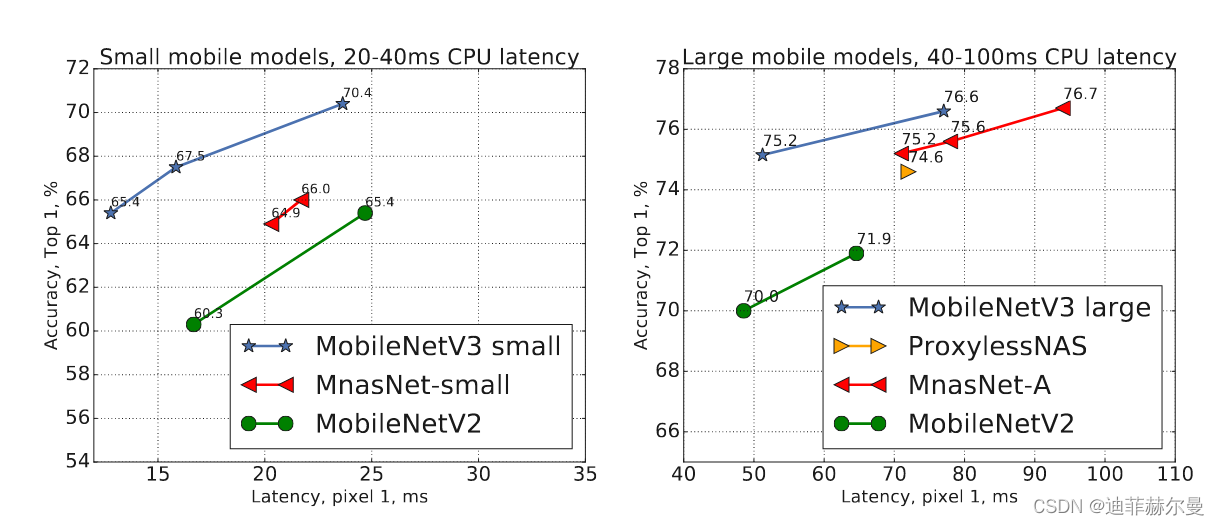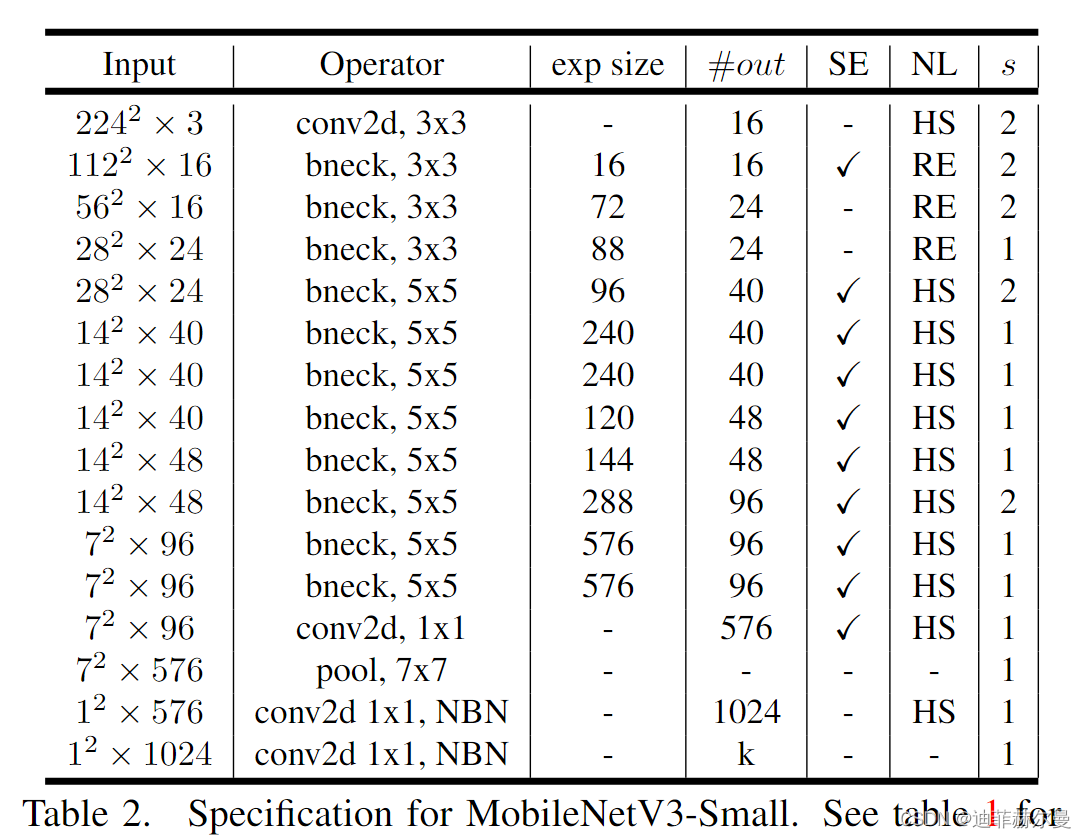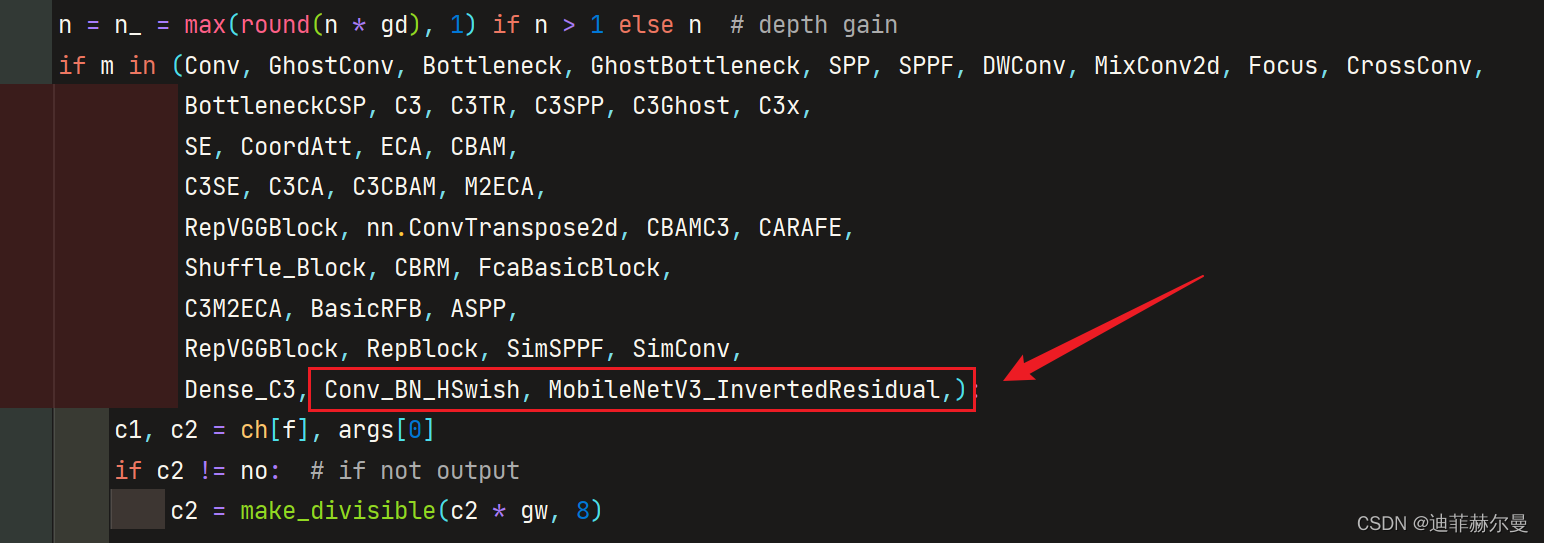

论文地址:https://arxiv.org/abs/1905.02244
代码地址:https://github.com/xiaolai-sqlai/mobilenetv3
我们展示了基于互补搜索技术和新颖架构设计相结合的下一代 MobileNets。MobileNetV3通过结合硬件感知网络架构搜索(NAS)和 NetAdapt算法对移动设计如何协同工作,利用互补的方法来提高移动端CPU推理整体水平。通过这个过程,创建了两个新的发布的 MobileNet模型:MobileNetV3-Large 和 MobileNetV3-Small,分别针对高资源和低资源用例。然后将这些模型应用于目标检测和语义分割。针对语义分割(或任何密集像素预测)任务,提出了一种新的高效分割解码器 Lite reduce Atrous Spatial Pyramid Pooling(LR-ASPP)。实现了移动端分类,检测和分割的最新SOTA成果。与 MobileNetV2 相比,MobileNetV3-Large 在 ImageNet 分类上的准确率提高了 3.2%,同时延迟降低了 20%。与 MobileNetV2 相比,MobileNetV3-Small 的准确率高 6.6%,同时延迟相当。 MobileNetV3-Large 检测速度比 MobileNetV2 快 25%,在COCO检测上的精度大致相等。MobileNetV3-Large LR-ASPP 的速度比 MobileNetV2 R-ASPP 快 30%,在 Cityscapes segmentation分割数据集上,MobileNetV3-Large LR-ASPP 比 MobileNet V2 R-ASPP 快 34%。
MobileNet V3 主要特点
- 论文推出两个版本:
Large和Small,分别适用于不同的资源用例; - 使用
NetAdapt算法获得卷积核和通道的最佳数量; - 继承
V1的深度可分离卷积; - 继承
V2的具有线性瓶颈的残差结构; - 引入
SE通道注意力结构; - 使用了一种新的激活函数
h-swish(x)代替Relu6,h的意思表示hard; - 使用了
Relu6(x + 3)/6来近似SE模块中的sigmoid; - 修改了
MobileNetV2后端输出head。
MobileNetV3网络结构
MobileNetV3-Large结构

将YOLOv5主干网络替换为MobileNetV3-large:
yolov5-mobilenetv3large-backbone.yaml
# parameters
nc: 80 # number of classes
depth_multiple: 1.0
width_multiple: 1.0
# anchors
anchors:
- [10,13, 16,30, 33,23] # P3/8
- [30,61, 62,45, 59,119] # P4/16
- [116,90, 156,198, 373,326] # P5/32
# MobileNetV3-large backbone
# MobileNetV3_InvertedResidual [out_ch, hid_ch, k_s, stride, SE, HardSwish]
backbone:
# [from, number, module, args]
[[-1, 1, Conv_BN_HSwish, [16, 2]], # 0-p1/2
[-1, 1, MobileNetV3_InvertedResidual, [ 16, 16, 3, 1, 0, 0]], # 1-p1/2
[-1, 1, MobileNetV3_InvertedResidual, [ 24, 64, 3, 2, 0, 0]], # 2-p2/4
[-1, 1, MobileNetV3_InvertedResidual, [ 24, 72, 3, 1, 0, 0]], # 3-p2/4
[-1, 1, MobileNetV3_InvertedResidual, [ 40, 72, 5, 2, 1, 0]], # 4-p3/8
[-1, 1, MobileNetV3_InvertedResidual, [ 40, 120, 5, 1, 1, 0]], # 5-p3/8
[-1, 1, MobileNetV3_InvertedResidual, [ 40, 120, 5, 1, 1, 0]], # 6-p3/8
[-1, 1, MobileNetV3_InvertedResidual, [ 80, 240, 3, 2, 0, 1]], # 7-p4/16
[-1, 1, MobileNetV3_InvertedResidual, [ 80, 200, 3, 1, 0, 1]], # 8-p4/16
[-1, 1, MobileNetV3_InvertedResidual, [ 80, 184, 3, 1, 0, 1]], # 9-p4/16
[-1, 1, MobileNetV3_InvertedResidual, [ 80, 184, 3, 1, 0, 1]], # 10-p4/16
[-1, 1, MobileNetV3_InvertedResidual, [112, 480, 3, 1, 1, 1]], # 11-p4/16
[-1, 1, MobileNetV3_InvertedResidual, [112, 672, 3, 1, 1, 1]], # 12-p4/16
[-1, 1, MobileNetV3_InvertedResidual, [160, 672, 5, 1, 1, 1]], # 13-p4/16
[-1, 1, MobileNetV3_InvertedResidual, [160, 672, 5, 2, 1, 1]], # 14-p5/32
[-1, 1, MobileNetV3_InvertedResidual, [160, 960, 5, 1, 1, 1]], # 15-p5/32
]
head:
[[-1, 1, Conv, [160, 1, 1]],
[-1, 1, nn.Upsample, [None, 2, 'nearest']],
[[-1, 13], 1, Concat, [1]], # cat backbone P4
[-1, 1, C3, [320, False]], # 19
[-1, 1, Conv, [320, 1, 1]],
[-1, 1, nn.Upsample, [None, 2, 'nearest']],
[[-1, 6], 1, Concat, [1]], # cat backbone P3
[-1, 1, C3, [360, False]], # 23 (P3/8-small)
[-1, 1, Conv, [360, 3, 2]],
[[-1, 20], 1, Concat, [1]], # cat head P4
[-1, 1, C3, [680, False]], # 26 (P4/16-medium)
[-1, 1, Conv, [680, 3, 2]],
[[-1, 16], 1, Concat, [1]], # cat head P5
[-1, 1, C3, [840, False]], # 29 (P5/32-large)
[[23, 26, 29], 1, Detect, [nc, anchors]], # Detect(P3, P4, P5)
]
MobileNetV3-Small结构

将YOLOv5主干网络替换为MobileNetV3-Small:
yolov5-mobilenetv3small-backbone.yaml
# YOLOv5 🚀 by Ultralytics, GPL-3.0 license
# Parameters
nc: 80 # number of classes
depth_multiple: 1.0 # model depth multiple
width_multiple: 1.0 # layer channel multiple
anchors:
- [10,13, 16,30, 33,23] # P3/8
- [30,61, 62,45, 59,119] # P4/16
- [116,90, 156,198, 373,326] # P5/32
# Mobilenetv3-small backbone
# MobileNetV3_InvertedResidual [out_ch, hid_ch, k_s, stride, SE, HardSwish]
backbone:
# [from, number, module, args]
[[-1, 1, Conv_BN_HSwish, [16, 2]], # 0-p1/2
[-1, 1, MobileNetV3_InvertedResidual, [16, 16, 3, 2, 1, 0]], # 1-p2/4
[-1, 1, MobileNetV3_InvertedResidual, [24, 72, 3, 2, 0, 0]], # 2-p3/8
[-1, 1, MobileNetV3_InvertedResidual, [24, 88, 3, 1, 0, 0]], # 3
[-1, 1, MobileNetV3_InvertedResidual, [40, 96, 5, 2, 1, 1]], # 4-p4/16
[-1, 1, MobileNetV3_InvertedResidual, [40, 240, 5, 1, 1, 1]], # 5
[-1, 1, MobileNetV3_InvertedResidual, [40, 240, 5, 1, 1, 1]], # 6
[-1, 1, MobileNetV3_InvertedResidual, [48, 120, 5, 1, 1, 1]], # 7
[-1, 1, MobileNetV3_InvertedResidual, [48, 144, 5, 1, 1, 1]], # 8
[-1, 1, MobileNetV3_InvertedResidual, [96, 288, 5, 2, 1, 1]], # 9-p5/32
[-1, 1, MobileNetV3_InvertedResidual, [96, 576, 5, 1, 1, 1]], # 10
[-1, 1, MobileNetV3_InvertedResidual, [96, 576, 5, 1, 1, 1]], # 11
]
# YOLOv5 v6.0 head
head:
[[-1, 1, Conv, [96, 1, 1]], # 12
[-1, 1, nn.Upsample, [None, 2, 'nearest']],
[[-1, 8], 1, Concat, [1]], # cat backbone P4
[-1, 3, C3, [144, False]], # 15
[-1, 1, Conv, [144, 1, 1]], # 16
[-1, 1, nn.Upsample, [None, 2, 'nearest']],
[[-1, 3], 1, Concat, [1]], # cat backbone P3
[-1, 3, C3, [168, False]], # 19 (P3/8-small)
[-1, 1, Conv, [168, 3, 2]],
[[-1, 16], 1, Concat, [1]], # cat head P4
[-1, 3, C3, [312, False]], # 22 (P4/16-medium)
[-1, 1, Conv, [312, 3, 2]],
[[-1, 12], 1, Concat, [1]], # cat head P5
[-1, 3, C3, [408, False]], # 25 (P5/32-large)
[[19, 22, 25], 1, Detect, [nc, anchors]], # Detect(P3, P4, P5)
]
在YOLOv5项目中添加方式:
common.py中加入以下代码:
# Mobilenetv3Small
class SeBlock(nn.Module):
def __init__(self, in_channel, reduction=4):
super().__init__()
self.Squeeze = nn.AdaptiveAvgPool2d(1)
self.Excitation = nn.Sequential()
self.Excitation.add_module('FC1', nn.Conv2d(in_channel, in_channel // reduction, kernel_size=1)) # 1*1卷积与此效果相同
self.Excitation.add_module('ReLU', nn.ReLU())
self.Excitation.add_module('FC2', nn.Conv2d(in_channel // reduction, in_channel, kernel_size=1))
self.Excitation.add_module('Sigmoid', nn.Sigmoid())
def forward(self, x):
y = self.Squeeze(x)
ouput = self.Excitation(y)
return x * (ouput.expand_as(x))
class Conv_BN_HSwish(nn.Module):
"""
This equals to
def conv_3x3_bn(inp, oup, stride):
return nn.Sequential(
nn.Conv2d(inp, oup, 3, stride, 1, bias=False),
nn.BatchNorm2d(oup),
h_swish()
)
"""
def __init__(self, c1, c2, stride):
super(Conv_BN_HSwish, self).__init__()
self.conv = nn.Conv2d(c1, c2, 3, stride, 1, bias=False)
self.bn = nn.BatchNorm2d(c2)
self.act = nn.Hardswish()
def forward(self, x):
return self.act(self.bn(self.conv(x)))
class MobileNetV3_InvertedResidual(nn.Module):
def __init__(self, inp, oup, hidden_dim, kernel_size, stride, use_se, use_hs):
super(MobileNetV3_InvertedResidual, self).__init__()
assert stride in [1, 2]
self.identity = stride == 1 and inp == oup
if inp == hidden_dim:
self.conv = nn.Sequential(
# dw
nn.Conv2d(hidden_dim, hidden_dim, kernel_size, stride, (kernel_size - 1) // 2, groups=hidden_dim,
bias=False),
nn.BatchNorm2d(hidden_dim),
nn.Hardswish() if use_hs else nn.ReLU(),
# Squeeze-and-Excite
SeBlock(hidden_dim) if use_se else nn.Sequential(),
# pw-linear
nn.Conv2d(hidden_dim, oup, 1, 1, 0, bias=False),
nn.BatchNorm2d(oup),
)
else:
self.conv = nn.Sequential(
# pw
nn.Conv2d(inp, hidden_dim, 1, 1, 0, bias=False),
nn.BatchNorm2d(hidden_dim),
nn.Hardswish() if use_hs else nn.ReLU(),
# dw
nn.Conv2d(hidden_dim, hidden_dim, kernel_size, stride, (kernel_size - 1) // 2, groups=hidden_dim,
bias=False),
nn.BatchNorm2d(hidden_dim),
# Squeeze-and-Excite
SeBlock(hidden_dim) if use_se else nn.Sequential(),
nn.Hardswish() if use_hs else nn.ReLU(),
# pw-linear
nn.Conv2d(hidden_dim, oup, 1, 1, 0, bias=False),
nn.BatchNorm2d(oup),
)
def forward(self, x):
y = self.conv(x)
if self.identity:
return x + y
else:
return y
yolo.py中添加如下代码:

本人更多YOLOv5实战内容导航🍀🌟🚀
-
手把手带你Yolov5 (v6.2)添加注意力机制(一)(并附上30多种顶会Attention原理图)🌟强烈推荐🍀新增8种
-
空间金字塔池化改进 SPP / SPPF / SimSPPF / ASPP / RFB / SPPCSPC / SPPFCSPC🚀
参考文献:
文章出处登录后可见!
